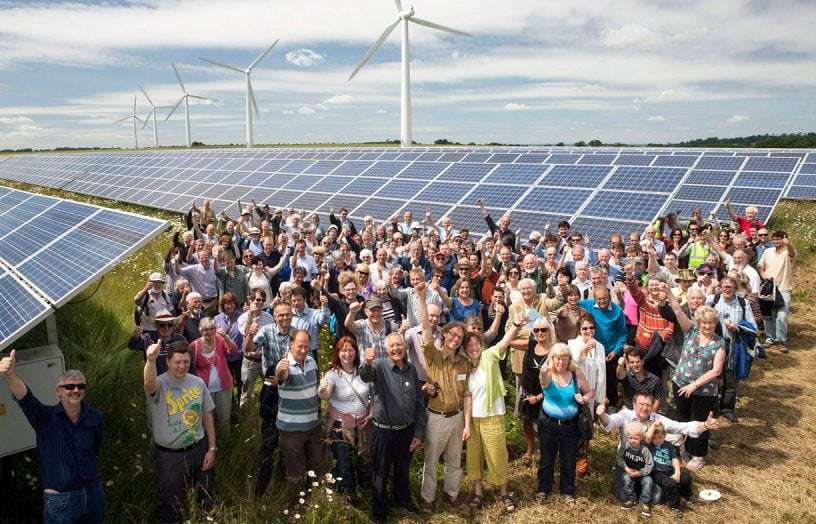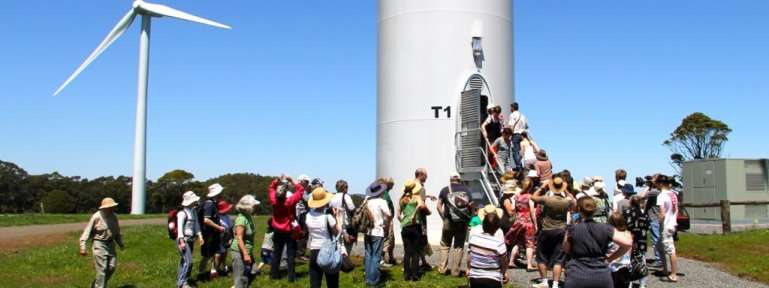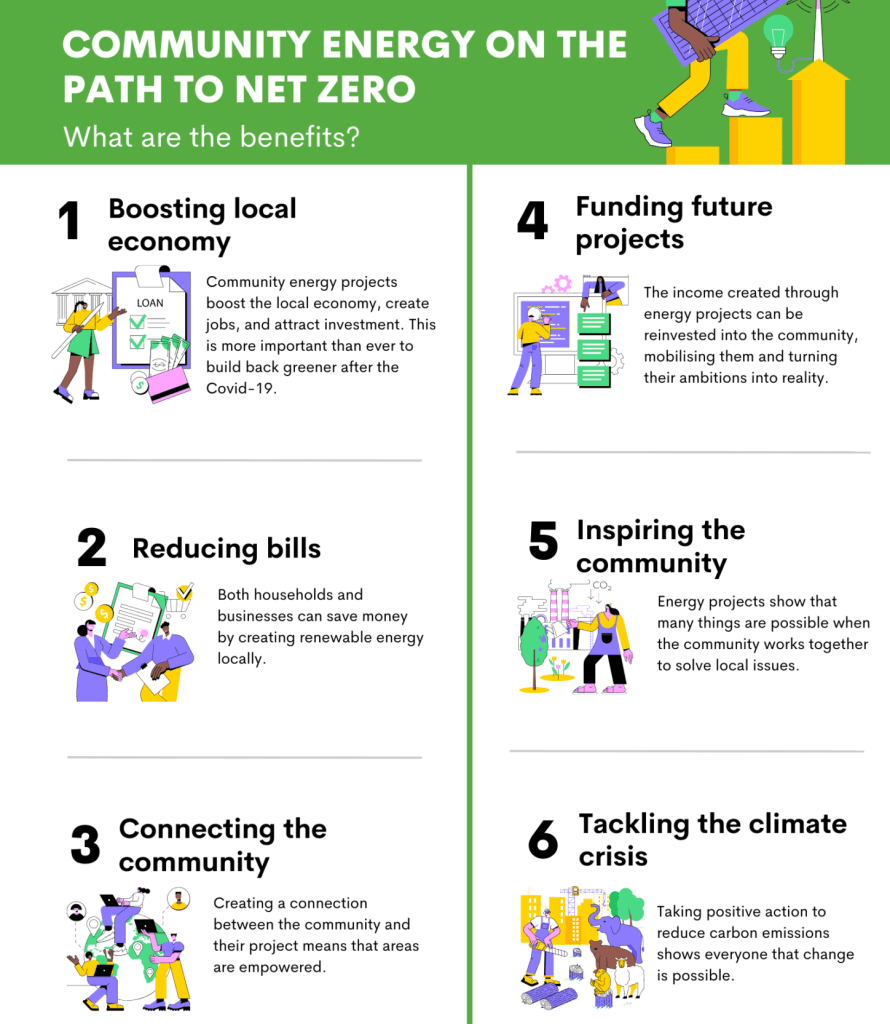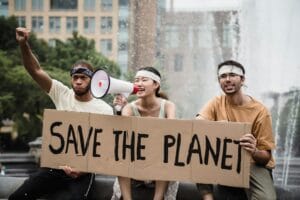Community renewable energy projects, often referred as Community Energy, are a great way to attain sustainability. It not only reduces energy use from conventional sources, but results in overall increased economic activities. It’s worthwhile to understand how such initiatives bring stability and reliability to power supply, reduced energy bills for consumers, financial independence to community and most importantly, create local jobs. In this article, we will try and understand the economic practices in community renewable energy projects and its overall impact on a community and economy.

Image Source: Renew
Community-Owned Renewable Energy Projects
To better understand community owned renewable energy projects, let’s visit a few key terms. The ‘Community‘ refers to a group of people with similar interest and characteristics living together within a large society. ‘Renewable energy‘ is energy generated from sources that are unlimited and free such as solar and wind. Lastly, ‘Community-owned‘ describes a scenario where group of like minded individuals come together to develop, own and operate assets to share benefits among the community they represent. When these concepts are combined, it represents a project generating carbon free energy through replenishable and free resources which is owned and operated by a community.
Community energy can take up various shapes and sizes depending upon the requirements and technology used, like solar, wind, and small hydro which are quite common. Other technologies are wave/tidal, geothermal, solar thermal, bioenergy and so forth. Whichever technology or combination of technology(s) are used, by enlarge one thing is common, the community is the energy producer as well as the consumer.
Few examples of successful Community Energy projects
- Middelgrunden Wind Farm – Built in 2000, its a 40 MW offshore wind farm in Copenhagen, Denmark. Funded through 50/50 ownership by 10,000 people investing in a cooperative, with the remaining funding provided by a municipal utility company. Today, it provides energy to more than 40,000 households, accounting to 4% of total Copenhagen electricity supply.
- Isle of Eigg: Until 2008, the residents of the island were dependent on Diesel gensets, moving since to generation through renewable energy systems. These consist of hydroelectric, wind, solar PV, and battery storage totalling 300 kW installed capacity. For backup a 65kW of diesel genset is used. The whole system is operated and maintained by a 100% owned subsidiary of Isle of Eigg Heritage Trust. Interestingly, repair and service of the system is solely done by residents who are specifically trained for it.
- Hepburn Community Wind Farm: It’s Australia’s first community wind farm located in Hepburn, Victoria. It generates enough energy to power 2300 homes through its 2 wind turbines with a total installed capacity of 4.1 MW. In 2007, local residents came together to create a co-operative and raised $9.8M. In addition to this, they raised another $4.83M as grants from various sources.

Source: Wikimedia

Source: Hepburn Energy
What Is The Significance of These Projects?
Adding to the list above, countries like Denmark, Germany, UK, Australia, USA, and Japan have set many examples for us to follow. Investing in such projects are not limited to accessing clean self-reliant energy, but, comes with many substantial benefits. Such as,
- Economical benefits: The community is actively involved in every phase and contribute to the cause throughout the lifecycle of the project. They share ownership and decision making in planning, funding, construction, operations, and maintainance of the project. It creates job and business opportunities for local residents, hence, strengthening the local economy.
- Social benefits: Such projects help in increased awareness among all ages for a sustainable world and thrivable future. The community becomes more responsible towards energy consumption, as a result, they can cut down on energy use, leading to increased savings. Community energy generates revenues, some of which may be reinvested in community development initiatives, empowering and making the community more resilient. For example, communities benefitting from geothermal power as shared here.
- Environmental benefits: Community energy brings overall health benefits to its residents by offering, pollutant free air, water and land. This is possible with a reduced carbon footprint through the use of the clean energy by residents.
- Energy security: Once successful, community energy is a great way to reduce dependencies on fossil fuels, commercial grids, unreliable power supply, volatile global market pricing, and defrays from high energy bills.
Moreover, governments in many countries have acknowledged such initiatives and reinforced community energy through supporting policies, grants and interest-free loans. Realizing this fact, not only contributes to a nation’s overall emissions reduction, but also creates a thriving economy hotspot.
Challenges to community energy
Community energy is gaining momentum in different parts of the World. But, there are many challenges that need continuous attention, some of them being:
- Accessing finance: It is the heart of all problems in many cases. To raise funds through voluntary contributions is a difficult task and may even take years before meeting the high upfront costs. To secure grants, interest free loans or even equipment donations from lenders, they need detailed study with financial viability for the proposed project. As selling a project plan based on socio-economic and environmental benefits alone, does not attract lenders or financial institutions. Moreover, it becomes very difficult when a community is lacking the experience and knowledge for such ventures.
- Social blockade: “Two people can see the same thing, disagree, and yet both be right. It’s not logical; it’s psychological.” – Stephen R. Covey. To put this into perspective, not everyone is always on the same side even though they may share the same habitat and common interest. Hence, many residents belonging to the same community may be reluctant to contribute in anyway towards such projects because of their own reservations or understandings.
- Government Will: Many countries have robust policies and regulations for centralised and large scale energy projects, but, lack any firm roadmap for a decentralised energy generation. In the presence of enabling forces such as strong government will, this can change the whole scenario for good. In Australia, there is no policy support for renewable energy projects between 1 to 30 MWs, as a result, there are low number of community energy initiatives.
Likewise, many challenges and barriers are added or discounted across places and jurisdictions. But, one thing is for sure, community energy contributes to overall reduction of carbon emissions and impacts society at large.
Economic Practices for Successful Projects
As mentioned, there are many examples of community energy around the World, supporting sustainable livelihoods. To understand this better, we will try and look at some economic practices or funding models behind such viable projects.
- Grants / Donations / Philanthropy: Community will raise funds through government grants or public schemes (national or council), donations or awards (sometimes equipment), or crowdfunding to support their efforts.
- Bank / Institutional Loans: A traditional way of raising money (debt financing) for a viable project is from financial institutions. Depending upon how supportive the policies are, terms and conditions will vary from country to country. Typically, a percentage of project cost is raised by community and rest is borrowed, which is then repaid within agreed period of time and interest. Sometimes, when banks are not convinced with the project, then, alternate options to raise money are Cooperative banks, Credit Unions, Non-profit organisations, Non-Banking Financial Corporations and likewise.
- Equity Financing: Community invites its residents to own and operate the project and receive returns on their investments. Investors in return, are given shares and opportunity to participate in decision making. It requires strong community support, technical and financial expertise, rigorous management and competent staff to develop and run such projects.
- Leasing: Community can lease a project to diversify from technical and financial risk. Where the maximum financial and technical risk is owned by the developer. By doing this a community gets enough time to raise funds and buy the installation after a certain period of time.
Why Observe Economic Practices in Renewable Energy Projects?
Community energy are important for society at large and not just for the people involved. Just imagine, throwing a pebble in a body of water, creating waves upon impact and moving outward thereafter. Considering this analogy, the project is the pebble, with the community being the impact point, and society is the area covered by the waves. Ironically, vibrations are strongest at impact point and start fading while covering a large area before it completely dies out. Its same for community projects, impact is strongest at point of installation, it benefits wider society before finally fading away.
So, its important to ensure the waves are always moving and never fade away. This simply means, we need more community energy to come up and impact more livelihoods in a thrivable way. It’s a fact, that numerous factors play a role in making community energy a success. Also, there are as many factors which hamper its growth as well, without realising the potential it holds. Many believe, if supportive policies are introduced, it can boost economic practices to encourage uptake of various community energy projects.

Source: Midlands Net Zero hub
Achieving the UN SDGs through Successful Community-Owned Renewable Energy Projects
Encouragement of community energy is important to provide energy security and addressing energy poverty ultimately leading to energy sustainability. There are several benefits that different stakeholders can reap at different levels. Benefits such as, political, social, economical, technological, and environmental. Overall, economic practices to promote community renewable energy projects are supportive of the UN sustainable development goals (SDGs):
SDG 7: Community energy holds immense potential to provide clean, affordable, reliable, sustainable and modern energy for all. In many countries, including developed ones, people in remote areas are heavily dependent on diesel generators. Alternatively, such projects have successfully reduced fossil fuel use leading to lower carbon emissions.
SDG 8: Community energy not only caters to energy requirements of a community resident, but, such economic practices create an economic hotspot. It brings resilience and empowerment through business and job creation. Leading to developments that are sustainable and inclusive whilst allowing for productive employment and decent work for all.
SDG 11: Such project have an overall positive impact on the community and its residents. It brings confidence in using renewable energy and using enough to fulfill their needs, hence reducing wastage. Moreover, it secures the residents from uncertain future energy prices and vulnerabilities of centralised power generation. Further, helping communities to preserve their landscape, heritage and natural resources for next generations in a thriving future.
A Thrivable Framework for community energy
Fighting climate change is not a lone battle, but to be fought with everyone’s participation. It can manifest either through an individual’s contribution to a larger cause or by an individual uniting people for a shared purpose. In another words, community energy are perfect reflection of the every same idea. Where the purpose remains the same, to achieve sustainability, and beyond thus attaining thrivability. To find out more about a first hand account on Community Energy, see Chris Weir’s presentation to the THRIVE community at this Thrivability Matters Webinar.
At THRIVE, our Tribe, advocates for better future, which is not only sustainable, but going beyond demanding for a Thrivable Earth. Our framework integrates 12 Foundational Focus Factors which work in tandem with one another. All in all helping us measure sustainability and creating a clear picture for future paths, with the intention of delivering on thrivability. At Thrive, we are committed to work on innovative solutions that reflects The Thrivable Framework. To learn more about us you can join our free newsletter, read information rich blogs, participate in live webinars, listen to podcast series, and watch our YouTube channel. There’s lot more exciting happening in our World, to know more do check our website. Until then, Keep Thriving!























